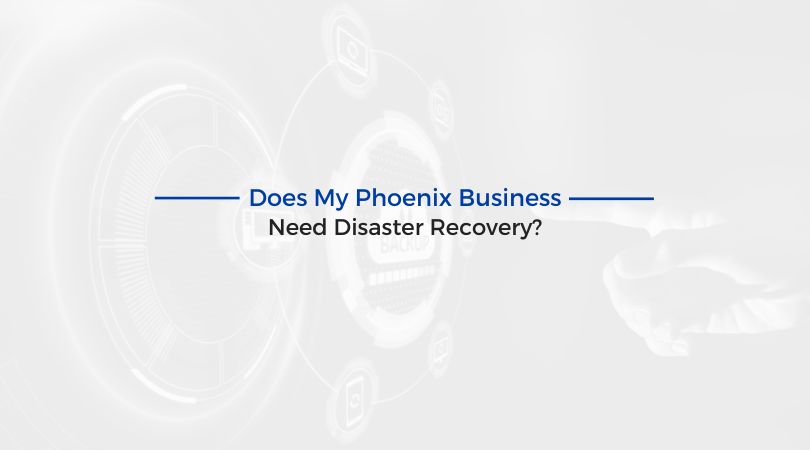The million-dollar question. It’s kind of like asking if you really need car insurance. You don’t think about it or need it until you get in a car crash–then suddenly, it’s vital.
The same goes for disaster recovery. Without a proper disaster recovery plan, a company risks reduced productivity, data loss, reputation damage, and out-of-budget recovery expenses. It’s also possible that a business disaster can put you out of business.
No matter your size or industry, your business must be able to recover quickly from any unfortunate event that impacts daily operations.
If you are a Phoenix area business without a disaster recovery plan, now is the time to act.
What is Considered a Business Disaster?
Typically when we hear the word “disaster,” we think of hurricanes or tsunamis. While these types of natural disasters are included, a business disaster can also be caused by a cyberattack, system failure, or human error.
Types of business disasters include:
- Natural disasters (tsunamis, hurricanes, floods, wildfires, tornados, etc.)
- Pandemics and epidemics
- Fires, whether accidental or arson
- Technological hazards (i.e., power outages, pipeline explosions, and transportation accidents)
- Cyber attacks (i.e., ransomware attacks, malware, or DDoS)
- Machine and hardware failure
- Other intentional, human-caused threats, such as terrorist or biochemical attacks
How Does Disaster Recovery Work?
The best disaster recovery plans for Phoenix businesses include three key components: 1) prevention, 2) detection, and 3) correction.
What does this mean?
Prevention means ensuring your systems are as reliable and secure as possible to prevent a disaster from happening to begin with. Preventive actions might include backing up critical data, continuously monitoring environments, and continuing to address error or compliance violations.
Detection refers to a business receiving information immediately that a disaster has occurred so they can initiate their action plan. To make your response and recovery as quick as possible, you need to know immediately when a disaster has happened so you can react appropriately. Detective measures include detecting unwanted intruders or activities as they occur as close to real-time as possible.
Corrective measures focus on planning for different types of potential business disasters and the necessary recovery associated. This means ensuring backup operations and putting recovery procedures into action to reduce the overall impact of a disaster. The goal is to restore data and systems quickly when disaster strikes.
Types of Disaster Recovery
Depending on your industry, compliance regulations for your industry, the type of disaster you anticipate could happen, and your existing IT infrastructure, the type of backup and recovery needed will vary. It also depends on the types and quantities of the assets your organization needs to protect.
A few standard techniques and technologies are used in most disaster recovery plans. Which type will best fit your business depends on the factors named above.
Backups
Backup data can be sent to an offsite system or shipped to an external drive at an offsite location. Note that backups are not considered a full disaster recovery solution because they do not include any IT infrastructure.
Backup as a Service (BaaS)
Similar to remote data backups, BaaS solutions provide regular data backups offered by a third-party provider.
Disaster Recovery as a Service (DRaaS)
DRaaS allows your company to back up data and IT infrastructure and then host them on a third-party provider’s platform. Many cloud providers offer this service. If a disaster occurs, the third-party provider would implement your DR plan and help return your organization to full operations as quickly as possible.
Point-in-time Snapshots
Snapshots replicate data, files, or even entire databases at a specific point in time. Snapshots can be used to restore data if the copy is stored in a location unaffected by the business disaster (this is key). Because snapshots are only taken at certain intervals, data loss can occur depending on when the last snapshot was created.
Virtual DR
Virtual DR solutions allow you to back up operations and data or even create a complete replica of your IT infrastructure and run it on offsite virtual machines (VMs). It’s important to note that this solution requires frequent data and workload transfers to really work. But, if used correctly, you can reload your backup and resume operations quickly in the event of a disaster.
Disaster Recovery Sites
Disaster recovery sites are locations that organizations can temporarily use after a disaster event, which contain backups of data, systems, and other technology infrastructure.
Disaster Recovery for Your Phoenix Business
Does my phoenix business need disaster recovery? That’s a great question and we believe we have the easy answer. The decision to establish a disaster recovery plan for your business should be a no-brainer. It’s your insurance policy when things don’t go according to plan. With various disaster recovery types and options, your business can find the right strategy to meet your operational and industry needs.
Are you looking to establish your business’s disaster recovery plan or develop a disaster recovery test plan checklist? PK Tech can help. Schedule a free 15-minute consultation with one of our experts.
